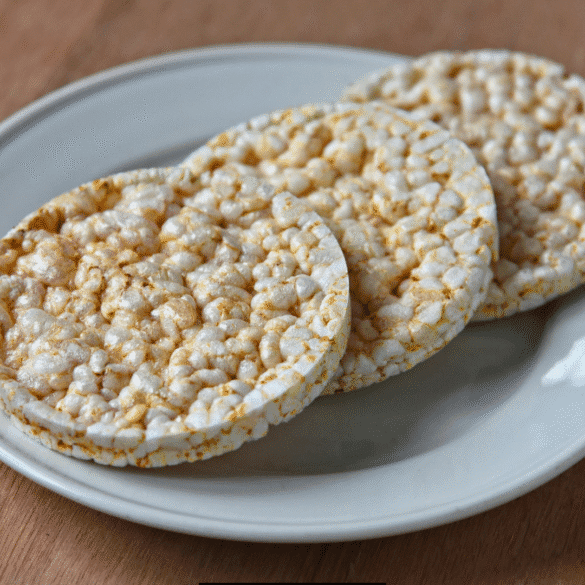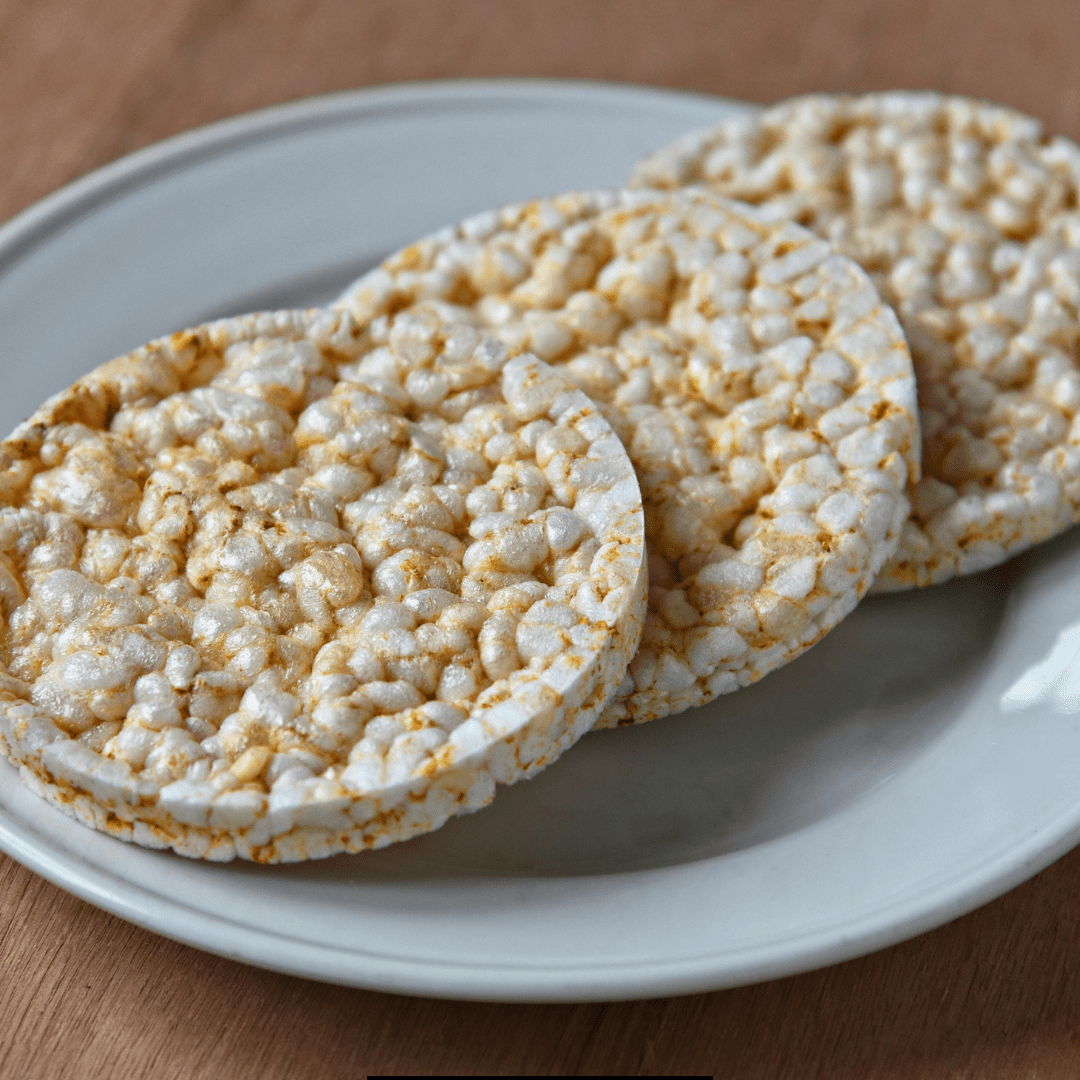Quaker Rice Cakes have long been a staple in my pantry, not just because they’re light and crunchy, but because they offer endless possibilities for creativity in the kitchen.
Table of Contents
How to make Quaker Rice Cakes
Quaker Rice Cakes are a light, crunchy snack made from puffed whole-grain brown rice that is pressed into a round cake shape. They’re often marketed as a healthier alternative to chips or crackers since they’re low in calories and fat.
Ingredients
- Rice: 1 cup of uncooked white or brown rice
- Water: 2 cups (for cooking the rice)
- Salt: ½ tsp, optional (for flavor)
- Oil or Nonstick Spray: To grease your mold or baking sheet
- Sweeteners or Flavorings (Optional): Honey, cinnamon, vanilla extract, or spices, depending on whether you want sweet or savory rice cakes
Equipment Needed
- Saucepan (to cook the rice)
- Baking sheet or rice cake mold
- Oven, stovetop, or air fryer (for puffing/cooking the rice cake)
- Blender or food processor (optional for blending rice into a dough-like consistency)
Instructions
Step 1: Begin by thoroughly cooking your rice using the instructions provided on the packaging. Combine 1 cup of rice with 2 cups of water and cook until the grains are soft and fully absorb the water. Let the rice cool slightly once cooked.
Step 2: If you’d like your rice cakes to have a blended texture like the store-bought ones, pulse the cooked rice in a food processor until it forms a slightly sticky and cohesive mixture. Alternatively, simply use cooked rice as-is for a more traditional and puffed look.
Step 3: Take small portions of the rice mixture (about 2-3 tablespoons each) and press them into flat, round shapes, about ¼ inch thick. You can use a rice cake mold or press them directly onto a greased baking sheet.
Step 4: Preheat your oven to 375°F (190°C). Place the shaped rice cakes on the baking sheet and bake for 12-15 minutes until they become crispy and slightly puffed. Alternatively, you can use an air fryer at 350°F (175°C) for around 10 minutes.
Step 5: Let your rice cakes cool completely before serving. You can enjoy them plain or add toppings like nut butter, fruits, hummus, or spices to enhance their flavor.
Tips for Making Perfect Rice Cakes
- Choose the Right Rice: Sticky or glutinous rice works best as it holds together better. If you’re using regular rice, pulse it slightly to achieve the desired texture.
- Add Flavor: Incorporate salt, honey, or spices into your rice mixture before shaping to enhance the overall taste.
- Experiment with Toppings: Don’t just stop at plain rice cakes! Try toppings like avocado and smoked salmon for savory snacks or peanut butter and banana slices for a sweet treat.
- Store Properly: Store rice cakes in an airtight container to keep them crispy. Homemade versions tend to spoil faster, so consume them within a few days.
- Control Thickness: Keep the rice cakes thin for a crispier texture or thicker if you prefer a chewy bite.
What to serve with
Quaker Rice Cakes are a versatile snack that can be customized to suit your cravings—whether you’re in the mood for a sweet treat, a savory bite, or even a protein-packed mini-meal.
Nut Butter + Fruit:
- Spread almond, peanut, or cashew butter over the rice cake.
- Top with fresh fruit like banana slices, strawberries, or blueberries.
- Add a drizzle of honey or sprinkle of cinnamon for extra flavor.
Greek Yogurt + Granola:
- Smear a layer of vanilla or plain Greek yogurt on the rice cake.
- Sprinkle granola, nuts, or seeds on top for crunch.
- Add a touch of maple syrup or fresh fruit for sweetness.
Chocolate Lovers Delight:
- Spread Nutella or a dark chocolate spread onto the rice cake.
- Top with sliced bananas, raspberries, or coconut flakes.
Caramel Apple Rice Cake:
- Spread a thin layer of caramel sauce or cream cheese onto a rice cake.
- Add thin slices of apple and sprinkle with cinnamon.
Cottage Cheese or Ricotta Combo:
- Spread ricotta or cottage cheese on the rice cake.
- Add honey, fresh pear slices, or a dash of cocoa powder.
Ingredients Substitutes
If you’re looking to recreate Quaker Rice Cakes at home from scratch, there are various ingredient substitutes you can use based on dietary preferences, allergen concerns, or your pantry’s inventory.
Substitutes for Rice
Rice is the key ingredient for traditional rice cakes, but if you’re looking for alternatives, here are some options:
Quinoa
Why It Works: Quinoa is similar in texture to rice, especially when cooked.
How to Use It: Replace rice with cooked quinoa and follow the same process for shaping and baking. Choose white quinoa for a milder flavor.
Benefits: Higher protein content and packed with nutrients like magnesium and iron.
Millet
Why It Works: Millet has a nutty flavor and can puff when cooked, mimicking the texture of rice cakes.
How to Use It: Cook millet until soft and use it as a direct substitute for rice in the recipe.
Benefits: Gluten-free and rich in fiber.
Cauliflower Rice
Why It Works: For a low-carb alternative, cauliflower rice can mimic the texture of puffed rice when baked or fried.
How to Use It: Steam or sauté cauliflower rice and mix it with a binding ingredient like egg whites before shaping.
Benefits: Great for keto diets and packed with vitamins C and K.
Barley or Farro
Why It Works: These grains add a chewy texture and can mimic the crunch of rice cakes.
How to Use It: Cook thoroughly, mash slightly to create a cohesive mixture, and bake.
Drawback: Contains gluten, so it is not suitable for gluten-free diets.
Substitutes for Binding Agents
Binding agents are essential to hold the grains together during the shaping process. If traditional methods aren’t available, try these options:
Egg Whites
Why It Works: Egg whites act as a natural binder while also helping the rice “puff” during baking.
How to Use It: Mix 1-2 egg whites into your rice mixture before shaping.
Benefits: Adds protein without extra fat.
Flaxseed or Chia Seeds
Why It Works: When mixed with water, flaxseeds or chia seeds create a gel-like texture that works as a plant-based binder.
How to Use It: Combine 1 tablespoon of chia or ground flaxseed with 2-3 tablespoons of water and let it sit for 5 minutes before mixing it into the rice.
Benefits: A vegan and gluten-free option that adds omega-3 fatty acids and fiber.
Mashed Sweet Potato or Pumpkin Puree
Why It Works: These starchy vegetables add a sticky texture that can bind rice together.
How to Use It: Add 2-3 tablespoons of mashed sweet potato or pumpkin to the rice mixture.
Benefits: Adds natural sweetness and nutrients like beta-carotene.
Cheese (Optional for Savory Versions)
Why It Works: Shredded cheese melts and helps bind the rice while adding flavor.
How to Use It: Sprinkle cheese into the rice mixture before baking.
Drawback: Best for savory rice cakes, not suitable for sweet variations.
Substitutes for Flavor Enhancers
If you’re making flavored rice cakes or want to adjust the seasoning, here are some alternatives:
Instead of Salt – Seaweed or Soy Sauce
Why It Works: Adds depth and umami flavor without plain salt.
How to Use It: Sprinkle finely crumbled seaweed (like nori) or mix a small dash of soy sauce into the rice mixture.
Benefits: Nutritional boost with minerals and amino acids.
Instead of Sugar – Honey or Maple Syrup
Why It Works: Natural sweeteners can replace sugar for a healthier option.
How to Use It: Drizzle honey or maple syrup into the rice mixture for subtle sweetness.
Drawback: May make the rice cakes slightly softer; adjust baking time to compensate.
Instead of Oil – Applesauce or Yogurt
Why It Works: Applesauce or plain yogurt can lend moisture without additional fat.
How to Use It: Add 1-2 tablespoons to your rice mixture. Choose unsweetened versions for neutral flavor.
Benefits: Lighter and more nutritious option.
Instead of Cinnamon – Cardamom or Nutmeg
Why It Works: Add warming spice flavors for variety in sweet rice cakes.
How to Use It: Use a pinch or a small amount, depending on your preference.
Final Thoughts
With these ideas, Quaker Rice Cakes can become more than just a quick snack—they can transform into a gourmet experience tailored to your tastes.
More Rice Cakes Recipes:

Ingredients
- Rice: 1 cup of uncooked white rice
- Water: 2 cups
- Salt: ½ tsp, optional (for flavor)
- Oil
- Sweeteners: Honey
Instructions
Step 1: Begin by thoroughly cooking your rice using the instructions provided on the packaging. Combine 1 cup of rice with 2 cups of water and cook until the grains are soft and fully absorb the water. Let the rice cool slightly once cooked.
Step 2: If you'd like your rice cakes to have a blended texture like the store-bought ones, pulse the cooked rice in a food processor until it forms a slightly sticky and cohesive mixture. Alternatively, simply use cooked rice as-is for a more traditional and puffed look.
Step 3: Take small portions of the rice mixture (about 2-3 tablespoons each) and press them into flat, round shapes, about ¼ inch thick. You can use a rice cake mold or press them directly onto a greased baking sheet.
Step 4: Preheat your oven to 375°F (190°C). Place the shaped rice cakes on the baking sheet and bake for 12-15 minutes until they become crispy and slightly puffed. Alternatively, you can use an air fryer at 350°F (175°C) for around 10 minutes.
Step 5: Let your rice cakes cool completely before serving. You can enjoy them plain or add toppings like nut butter, fruits, hummus, or spices to enhance their flavor.
